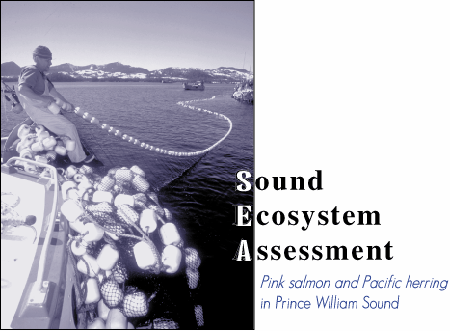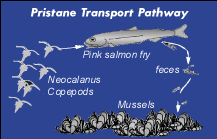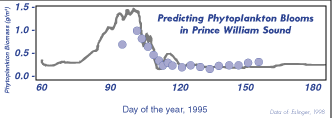
The 1993 collapse of the herring population in Prince William Sound, followed that summer by a poor return of pink salmon, served as a clarion call for a better understanding of the sound ecosystem.
Prince William Sound endured a major ecosystem change after the 1964 earthquake when subtidal areas were lifted above the tide line and community oil tanks were laid open by tsunamis. Twenty-five years later, the northern Gulf of Alaska absorbed the largest oil spill in U.S. history. Along the coast of the northern gulf is where more than half of Alaska's population lives, works, and plays and it is a destination point for many of the one million tourists who vacation in Alaska each summer.
Understanding both the natural changes and the human impacts on the region is vital to maintaining this rich ecosystem on which Alaskans depend.
The Sound Ecosystem Assessment (SEA) project is the largest of the ecosystem-scale research projects funded by the Trustee Council. SEA was initiated by commercial fishers and implemented by a team of research scientists coordinated out of Cordova. It included more than a dozen integrated components organized to obtain a clear understanding of the factors that influence productivity of Pacific herring and pink salmon in Prince William Sound.
This project has produced new information about the survival needs of juvenile herring and unraveled mysteries showing the effects of wind and ocean currents on plankton, the very base of the food chain. Researchers have developed a clear new picture of how pink salmon fry, no more than three inches in length, dodge predators and fatten up on plankton during their first few months in saltwater when their survival is most in doubt.
Pink Salmon
Pink salmon hatch in the streams of Prince William Sound or in the incubators of five hatcheries in the area. During the spring, they emerge from the streams or are released from the hatcheries to begin their migration out of the sound and into the northern Pacific. Research scientists chose to focus their studies at the point where pink salmon appear to be most vulnerable: as fry trying to survive the migration to the open ocean.

Pink salmon fry, in salt water for the first time, must quickly fatten up on animal plankton and at the same time avoid predators that must fatten up on them. Why is it that some years they do this with great success and return as adults in large numbers the following year, while in other years the survival of fry is poor and the adult return dismal?
SEA researchers began their focus on plant and animal plankton. They knew that plankton come from two main sources. Winds and currents can sweep plankton into the sound from the Gulf of Alaska. Or plankton can emerge from the deep recesses of Prince William Sound, including an area reaching 700 meters in depth known locally as the "black hole." But it was not known whether the black hole could produce enough plankton to support the needs of the sound or whether the sound was dependent on production in the Gulf of Alaska.
To determine this, SEA researchers developed a computer-based circulation model that predicts the movement of currents in the sound. A powerful computer was used to simulate circulation using information about the underwater landscape, inflow of saltwater from the Gulf of Alaska, inflow of freshwater from streams, tides, and winds.
Basketball-sized buoys were released at different locations in the sound to help validate the predictions of the model. The buoys, tracked by satellite, measured currents at the surface and at 15 meters depth.
The circulation model provided a wealth of information about how water movement impacts biological processes. For instance, the model simulated what would happen as plankton eggs, deep in the black hole, floated to the surface. In this way, scientists were able to determine that zooplankton from the black hole were retained in the sound for several months, meaning that the region was not wholly dependent on the gulf for food. The circulation model, using 1996 data, showed that plankton in the southeast portion of the sound were from the gulf while the majority of plankton in the western corridor were from the nearby black hole.
Another SEA model involved the groundbreaking work of predicting when the plankton blooms (the peak of plankton abundance) will occur. The timing and duration of the blooms have enormous implications for survival of salmon fry. Depending on conditions, the onset of the blooms can vary year to year by several weeks. Drs. David Eslinger and Peter McRoy developed a highly accurate model that is based on easily monitored ocean and weather conditions (Figure 1). In general, they found that during stormy, windy years, the onset of plankton blooms are late but prolonged, while those in calm years are early, intense, and short-lived.

Other SEA researchers were simultaneously working on another key question: Which is more limiting to salmon fry, food or predation?
SEA's salmon researchers mounted an intensive sampling campaign. Salmon fry and predator fish were caught, counted, weighed, their distributions mapped, and their stomach contents examined to find out their eating habits. Although it was generally known which fish preyed on salmon fry, it was not clearly known how much of an impact different predators had on the salmon population.
Researchers were able to show that pollock are the dominant predator on pink salmon fry, and that knowledge helped confirm an ecological theory. The plankton blooms not only feed the salmon fry, they also help shield them from predators. Scientists determined that, depending on the size and timing of the plankton bloom, pollock may prefer to feed on plankton instead of fry. The opportunistic pollock will feed on whatever prey provides the most energy for the least effort, and this often means they prefer floating plankton over the swimming salmon. When plankton is plentiful, salmon fry are less likely to be preyed upon.
To gauge the impact of this discovery, SEA developed another computer-based model. This model was designed to simulate the migration path of the fry. As the fry disperse and move toward the ocean, the computer model predicts where they will go, what food they will encounter, and what predators will encounter them.
The model is more than a fascinating look at predator-prey relationships. It has some very practical applications. In some circumstances, for example, it's better for the survival of fry when hatchery managers release them en masse. But other marine conditions call for a different strategy. When the zooplankton bloom is weak, it can make better sense to release the fry in batches.
Although there are many factors involved in fry survival, SEA has narrowed the field to a subset that can be monitored: light, temperature, fry size at release, fry density and group clustering, plankton bloom timing and abundance, and predator composition and size. These data can be used in a computer model to predict the survival of salmon fry, thereby providing a new tool to more accurately predict the return of adult pink salmon the following year.
So what have we learned from SEA?
The basic scientific knowledge gained is almost incalculable and new discoveries will continue as data are analyzed for many years to come. But of more immediate importance are the practical applications for users of the gulf ecosystem.
SEA has developed models that can now tell us where the plankton is coming from, where the currents will take it, when the bloom will occur and how strong it will be. Predator-prey models predict the survival rate of salmon fry.
This information is important not only when it comes to planning the release of fry from hatcheries and in forecasting the return of those salmon the following year, but also in understanding how salmon survive and grow.
Pacific Herring
Herring spawn in early April and the hatched larvae spend months drifting around Prince William Sound. Like the plankton, herring larvae are at the mercy of the currents until they metamorphose into juvenile fish in August.
Just as they did with pink salmon, SEA researchers focused primarily on the early stages of life as the most critical for herring survival. What were they feeding on? How did they survive the winter when plankton were practically non-existent? Unlike pink salmon, very little was known about the first year of life for Pacific herring. Researchers were pretty much starting from scratch.
The SEA herring team conducted a painstaking series of surveys to map the distribution of the juvenile herring and document their habitat needs. The groundbreaking information they gathered depended on a highly coordinated series of aerial surveys, hydroacoustic surveys, and intensive net sampling efforts.
SEA learned that young herring begin appearing in small bays in late July and August each year and were feeding on plankton into the fall. However, by late fall their food supply nearly disappears.
It turned out that juvenile herring must survive three or four months with very little food. They fast and preserve their energy, or "cut power and float," as some scientists refer to it. If they fail to store up enough energy for the winter, they may die. The energy reserves of the herring, the severity of the winter, and the bay in which they overwinter all play significant roles in their survival.
Dr. A.J. Paul went to eight different Prince William Sound bays in March and measured the energy reserves of juvenile herring found there. He found that the herring in Simpson, Sheep, and Boulder bays had plenty of reserves to survive the winter. Juvenile herring in Jack and Whale bays were low on reserves and those in Eaglek, Paddy, and Drier bays were near the point of starvation. This information confirmed that a particularly cold or stormy winter could cause starvation in many areas and lead to a poor return as adults.
Once again, the SEA modelers took this information and built it into a model for herring overwintering survival. The model inputs body protein and energy content measured from a sample of young herring in late fall and, based on expected winter temperatures, estimates the proportion of herring that will survive until spring. This provides another tool for better predicting the survival of a herring year class.
Development of the various SEA models is continuing. More fine tuning and testing must be done before they can be used routinely for management purposes.
Click HERE to view the complete Sound Ecosystem Assessement (SEA) Final Report.
